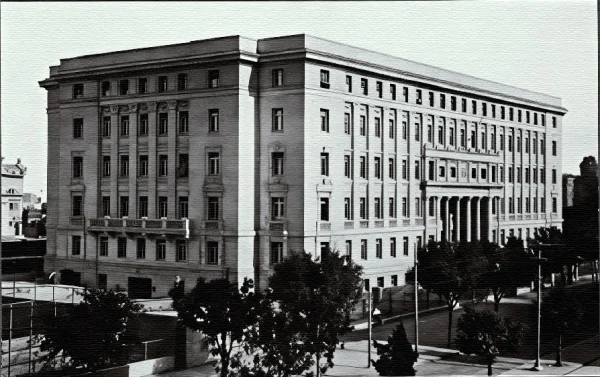
Central Ramses: Witness to Cairo’s transformations and the history of telecommunications in Egypt
The Central Ramses building has witnessed the city’s transformations since its construction at the beginning of the last century. Since then, three main buildings have emerged, led by the historic Central Ramses building, which represented a turning point in call management. The oldest of these buildings is the Diwan Building, followed by the Auto Building, and then the third and newest building, which recently suffered a major fire, highlighting the historical value and impact of the fire on the modern building, as well as its potential repercussions on its historical counterpart.
The beginning of the telephone in Egypt
The history of the telephone in Egypt dates back to 1881, when the Egyptian government granted a license to the American company “Edison Bell” to establish a telephone network in the cities of Cairo and Alexandria and their suburbs, according to the encyclopedia “Cairo in a Thousand Years” by Dr. Zaki Abdel Rahman.
This came 17 years after the establishment of the Telephone and Telegraph Authority in Egypt, coinciding with the establishment of the first telegraph line to secure railway services. Telegraph lines later appeared in royal palaces, where they were used as a means of communication with other countries by connecting them to an international maritime line.
Cairo Telephones
The telephone service connected the governorates of Cairo and Alexandria, and the telephone spread in Egypt during the British occupation in 1882, when the British sought to increase the number of cables in the governorates where they were present, such as the canal cities.
Special attention was given to telecommunications, and these services were transferred to Egypt. In 1888, a manual “Magneto” switchboard was put into operation, serving 3,000 lines at the time, and remained in service until 1936.
The license to operate the network was later transferred to the Eastern Company, then to the Telephone Company. By 1900, telephone communications had spread throughout the governorates of Egypt. In 1918, the government purchased the telephone facilities for 750,000 pounds and incorporated them into the Telegraph Authority.
Opening of the Ramses Central Station
According to the encyclopedia “Cairo in a Thousand Years,” 1926 saw the opening of the automatic Ataba Central Station, through the installation of a “Be Struger” unit.
According to Sabah Al-Khair magazine (issue 2001), the Cairo Central Station, known as the “Ramses Central Station,” was introduced the following year (1927) with a shared battery system and a capacity of 6,000 lines. The building was constructed on Queen Nazli Street (now Ramses Street), and the number of lines at that time reached 3,000.
The “New Telephone House” was opened on May 25, 1927, at the same location, later known as “Ramses Central.” In 1928, a similar central office was installed in Alexandria.
Encyclopedia of Cairo in 100 Years by Dr. Zaki Abdel RahmanCentral Ramses in the downtown area
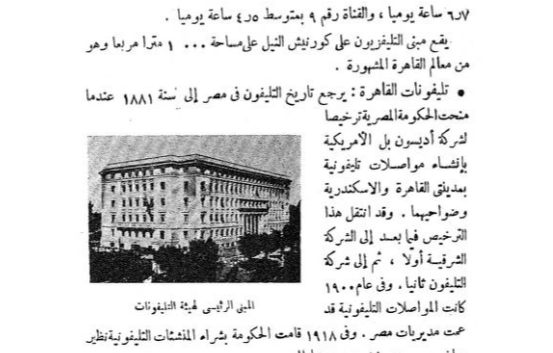
Registration of the Ramses Central Building as a historical monument
Soha Al-Miniawi, an eyewitness to the fire, told Bab Al-Masr that the Ramses Central Building consists of three buildings, the first being the Diwan building, which is the oldest, followed by the Auto building, and then the third and newest building. She added: “The fire broke out in the third building, where I work.”
The Diwan building is only two years away from reaching 100 years since its construction, which is the legal period required for it to be registered as a historic building. Will its exposure to the effects of the fire, such as smoke and high temperatures, affect its registration?
Bab Al-Masr contacted Dr. Abdelhamid Al-Kafafi, former director general of planning and follow-up for the restoration of antiquities, who confirmed that the building has not yet been included in the list of historic buildings.
He added: “Therefore, it is not subject to the law on the protection of antiquities and does not fall within the responsibilities of the Ministry of Tourism and Antiquities or the Supreme Council of Antiquities.”
Al-Kafafi explained in exclusive comments that the building is a key part of Egypt’s infrastructure and an important artery for communications and digital transformation. He added, “I don’t know if there’s an alternative in case of an emergency, but it’s something we need to think about for the future.”
Chances of registering the building
Regarding the chances of registering the old building as a monument in the future, Al-Kafafi pointed out that the registration of any building as a monument is subject to a set of criteria, most notably that it must be 100 years old and have distinctive architectural and decorative elements, in addition to building materials and design details that reflect its historical or artistic value.
He added: “Buildings that meet these requirements can be registered as monuments, even if they still serve a practical function. Registration does not necessarily mean that they will be converted into museums or that their use will be discontinued.”
Call accounting system
In 1931, the three main exchanges in Cairo (Al-Madina, Al-Bustan, and Al-Ataba) were converted into a single automatic exchange with a capacity of 20,000 lines, and a call accounting system for local telephone calls was introduced in 1933.
At the same time, an automatic exchange dedicated to government ministries was opened. The Heliopolis exchange also switched to the automatic system in 1934, the year in which the first telephone directory for Cairo and Alexandria was published. In 1936, the Giza exchange also switched to the automatic system.
Each subscriber was allowed to make 2,000 calls per year within the subscription fee. Any additional calls were charged at 3 millimes per call. The annual subscription fee was 8 pounds, payable in two installments, and was later increased to 12 pounds, with the cost of additional calls increasing to 15 millimes.
The development of the Ramses Central Office
The year 1947 saw a new upgrade to the Ramses Central Office’s operating mechanism. According to the newspaper Al-Ahram Al-Iqtisadi, the central office was converted to an electromechanical system. Later, electromagnetic exchanges with a “crossbar” system were installed, followed by electronic exchanges, and then digital exchanges. The first system (electromechanical) began operating in 1947 with a capacity of 40,000 lines at the central exchange in downtown Cairo.
In 1990, a contract was signed to build a new factory for the production of digital electronic exchanges in 6th of October City, with the participation of the Egyptian Telecommunications Company, the Egyptian Telephone Equipment Manufacturing Company, and the German company Siemens. In the same year, the national information transmission network was established, specifically for commercial and industrial institutions.
International calls from Ramses Central
According to the Egyptian Telecommunications Company, the role of Ramses Central was not limited to local communications. The company agreed with Marconi to install the first antenna transmission and reception station in Egypt in 1928, with the aim of establishing an international communications network.
The project was implemented in 1930 with the operation of the first automatic rotary switchboard at Ramses Central. In 1932, the underground cables between Cairo and Alexandria were replaced with aerial lines, which contributed to the completion of the first wireless connection between Egypt and England, where the first successful international call was made.
The Telephone and Telegraph Authority continued to operate until 1957, when the Telecommunications Authority was established and took over the rights to operate telecommunications services.
Ramses Central in cinema
The status of Ramses Central as a vital and important center in Egypt inspired writers and filmmakers, and it was a central element in many works of art. The most notable of these is the 1991 film Playing with the Big Boys.
In this film, actor Mahmoud El-Gendy plays a worker at the central office who eavesdrops on the calls of senior government officials. He passes the information on to his friend Adel Imam, who uses it to fight corruption.
According to the book Comedy and Singing in Egyptian Film by critic Mahmoud Qasim: “In Central Ramses, the worker eavesdropped on calls and knew about suspicious activities. He joined forces with his colleague to fight evil as much as possible. They were bound together by a deep friendship and shared concerns that made their fates intertwined.”
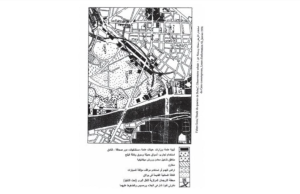
Location of Central Ramses
Central Ramses is located in a lively area in central Cairo that is never free of traffic. According to the book Cairo by author Mohamed Riad, the traffic on Al-Galaa Street is due to the fact that it is the only street that runs south from Bab Al-Hadid to Tahrir Square. It is parallel to Ramses Street.
The author adds: “The street is almost exclusively occupied by public buildings serving a variety of purposes. At one end is a building housing the North Cairo Real Estate Registry and several specialized courts. Then comes the Azbakeya Police Station, the Railway Hospital, the Industrial Bank, the North Cairo Court Complex, and the towers of Al-Ahram and Akhbar Al-Youm. There is also the Al-Galaa Maternity Hospital, the Leonardo Da Vinci Institute, several government buildings and poor houses, until we reach the Hilton Ramses and Martyr Abdel Moneim Riad Square.”
He continues: “The eastern side overlooks the rear facades of huge public buildings on Ramses Street, such as the Chemistry Authority, Central Ramses, the Ambulance Association, and the Engineers’ Syndicate.”
Until the early 1950s, Al-Galaa Street was full of empty spaces and had little traffic compared to Ramses Street. Its most active area was at its intersection with Fouad Street (now 26 July Street), which was connected by tram from Al-Ataba to Boulaq, Zamalek, and Imbaba.
The author explains that the reason for the congestion on Ramsis and Al-Galaa Streets was that both were the route of two adjacent canals extending from the Nile north of All Saints Church. They were filled in at the end of the 19th century, along with the Egyptian Gulf from the mouth of the Gulf to Ghamra in 1899.
Read also:
In the shade of the grapes: The history of child and girl labor from the notebooks of ancient Egypt
Samar Doidar: Palestinians are not numbers… and “Palestinian Stories” is the proof



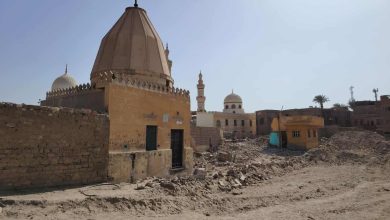
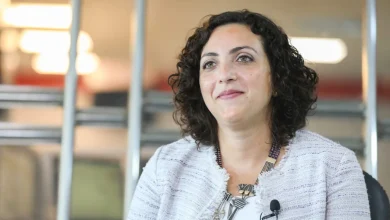
Hi, this is a comment.
To get started with moderating, editing, and deleting comments, please visit the Comments screen in the dashboard.
Thank you for your sharing. I am worried that I lack creative ideas. It is your article that makes me full of hope. Thank you. But, I have a question, can you help me?
Can you be more specific about the content of your article? After reading it, I still have some doubts. Hope you can help me.
Your point of view caught my eye and was very interesting. Thanks. I have a question for you. https://accounts.binance.com/hu/register?ref=IQY5TET4